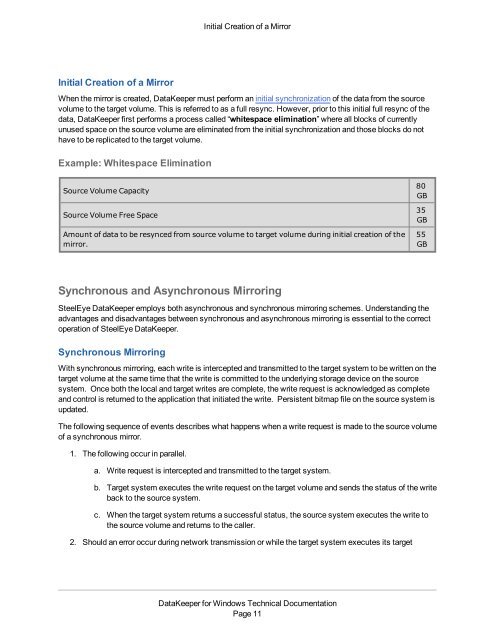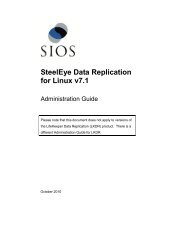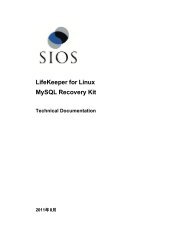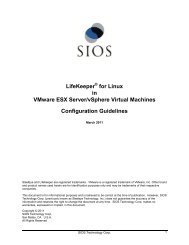DataKeeper for Windows All Documentation - SIOS
DataKeeper for Windows All Documentation - SIOS
DataKeeper for Windows All Documentation - SIOS
Create successful ePaper yourself
Turn your PDF publications into a flip-book with our unique Google optimized e-Paper software.
Initial Creation of a MirrorInitial Creation of a MirrorWhen the mirror is created, <strong>DataKeeper</strong> must per<strong>for</strong>m an initial synchronization of the data from the sourcevolume to the target volume. This is referred to as a full resync. However, prior to this initial full resync of thedata, <strong>DataKeeper</strong> first per<strong>for</strong>ms a process called “whitespace elimination” where all blocks of currentlyunused space on the source volume are eliminated from the initial synchronization and those blocks do nothave to be replicated to the target volume.Example: Whitespace EliminationSource Volume CapacitySource Volume Free SpaceAmount of data to be resynced from source volume to target volume during initial creation of themirror.80GB35GB55GBSynchronous and Asynchronous MirroringSteelEye <strong>DataKeeper</strong> employs both asynchronous and synchronous mirroring schemes. Understanding theadvantages and disadvantages between synchronous and asynchronous mirroring is essential to the correctoperation of SteelEye <strong>DataKeeper</strong>.Synchronous MirroringWith synchronous mirroring, each write is intercepted and transmitted to the target system to be written on thetarget volume at the same time that the write is committed to the underlying storage device on the sourcesystem. Once both the local and target writes are complete, the write request is acknowledged as completeand control is returned to the application that initiated the write. Persistent bitmap file on the source system isupdated.The following sequence of events describes what happens when a write request is made to the source volumeof a synchronous mirror.1. The following occur in parallel.a. Write request is intercepted and transmitted to the target system.b. Target system executes the write request on the target volume and sends the status of the writeback to the source system.c. When the target system returns a successful status, the source system executes the write tothe source volume and returns to the caller.2. Should an error occur during network transmission or while the target system executes its target<strong>DataKeeper</strong> <strong>for</strong> <strong>Windows</strong> Technical <strong>Documentation</strong>Page 11
















